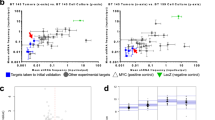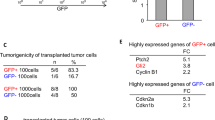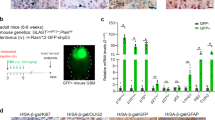Abstract
SOX5 is a member of the high-mobility group superfamily of architectural non-histone proteins involved in gene regulation and maintenance of chromatin structure in a wide variety of developmental processes. Sox5 was identified as a brain tumor locus in a retroviral insertional mutagenesis screen of platelet-derived growth factor B (PDGFB)-induced mouse gliomas. Here we have investigated the role of Sox5 in PDGFB-induced gliomagenesis in mice. We show that Sox5 can suppress PDGFB-induced glioma development predominantly upon Ink4a-loss. In human glioma cell lines and tissues, we found very low levels of SOX5 compared with normal brain. Overexpression of Sox5 in human glioma cells led to a reduction in clone formation and inhibition of proliferation. Combined expression of Sox5 and PDGFB in primary brain cell cultures caused decreased proliferation and an increased number of senescent cells in the Ink4a−/− cells only. Protein analyses showed a reduction in the amount and activation of Akt and increased levels of p27Kip1 upon Sox5 expression that was dominant to PDGFB signaling and specific to Ink4a−/− cells. Upon inhibition of p27Kip1, the effects of Sox5 on proliferation and senescence could be reversed. Our data suggest a novel pathway, where Sox5 may suppress the oncogenic effects of PDGFB signaling during glioma development by regulating p27Kip1 in a p19Arf-dependent manner, leading to acute cellular senescence.
This is a preview of subscription content, access via your institution
Access options
Subscribe to this journal
Receive 50 print issues and online access
$259.00 per year
only $5.18 per issue
Buy this article
- Purchase on Springer Link
- Instant access to full article PDF
Prices may be subject to local taxes which are calculated during checkout






Similar content being viewed by others
References
Akiyama H, Chaboissier MC, Martin JF, Schedl A, de Crombrugghe B . (2002). The transcription factor Sox9 has essential roles in successive steps of the chondrocyte differentiation pathway and is required for expression of Sox5 and Sox6. Genes Dev 16: 2813–2828.
Bringold F, Serrano M . (2000). Tumor suppressors and oncogenes in cellular senescence. Exp Gerontol 35: 317–329.
Chu IM, Hengst L, Slingerland JM . (2008). The Cdk inhibitor p27 in human cancer: prognostic potential and relevance to anticancer therapy. Nat Rev Cancer 8: 253–267.
Connor F, Cary PD, Read CM, Preston NS, Driscoll PC, Denny P et al. (1994). DNA binding and bending properties of the post-meiotically expressed Sry-related protein Sox-5. Nucleic Acids Res 22: 3339–3346.
Dai C, Celestino JC, Okada Y, Louis DN, Fuller GN, Holland EC . (2001). PDGF autocrine stimulation dedifferentiates cultured astrocytes and induces oligodendrogliomas and oligoastrocytomas from neural progenitors and astrocytes in vivo. Genes Dev 15: 1913–1925.
Dimri GP, Lee X, Basile G, Acosta M, Scott G, Roskelley C et al. (1995). A biomarker that identifies senescent human cells in culture and in aging skin in vivo. Proc Natl Acad Sci USA 92: 9363–9367.
Dong C, Wilhelm D, Koopman P . (2004). Sox genes and cancer. Cytogenet Genome Res 105: 442–447.
Goldstein S . (1990). Replicative senescence: the human fibroblast comes of age. Science 249: 1129–1133.
Hagerstrand D, Hesselager G, Achterberg S, Wickenberg Bolin U, Kowanetz M, Kastemar M et al. (2006). Characterization of an imatinib-sensitive subset of high-grade human glioma cultures. Oncogene 25: 4913–4922.
Holland EC, Celestino J, Dai C, Schaefer L, Sawaya RE, Fuller GN . (2000). Combined activation of Ras and Akt in neural progenitors induces glioblastoma formation in mice. Nat Genet 25: 55–57.
Huang DY, Lin YT, Jan PS, Hwang YC, Liang ST, Peng Y et al. (2008). Transcription factor SOX-5 enhances nasopharyngeal carcinoma progression by down-regulating SPARC gene expression. J Pathol 214: 445–455.
Jen J, Harper JW, Bigner SH, Bigner DD, Papadopoulos N, Markowitz S et al. (1994). Deletion of p16 and p15 genes in brain tumors. Cancer Res 54: 6353–6358.
Johansson FK, Brodd J, Eklof C, Ferletta M, Hesselager G, Tiger CF et al. (2004). Identification of candidate cancer-causing genes in mouse brain tumors by retroviral tagging. Proc Natl Acad Sci USA 101: 11334–11337.
Kamb A, Gruis NA, Weaver Feldhaus J, Liu Q, Harshman K, Tavtigian SV et al. (1994). A cell cycle regulator potentially involved in genesis of many tumor types. Science 264: 436–440.
Lee BY, Han JA, Im JS, Morrone A, Johung K, Goodwin EC et al. (2006). Senescence-associated beta-galactosidase is lysosomal beta-galactosidase. Aging Cell 5: 187–195.
Lefebvre V, Li P, de Crombrugghe B . (1998). A new long form of Sox5 (L-Sox5), Sox6 and Sox9 are coexpressed in chondrogenesis and cooperatively activate the type II collagen gene. EMBO J 17: 5718–5733.
Li DM, Sun H . (1998). PTEN/MMAC1/TEP1 suppresses the tumorigenicity and induces G1 cell cycle arrest in human glioblastoma cells. Proc Natl Acad Sci USA 95: 15406–15411.
Liang J, Zubovitz J, Petrocelli T, Kotchetkov R, Connor MK, Han K et al. (2002). PKB/Akt phosphorylates p27, impairs nuclear import of p27 and opposes p27-mediated G1 arrest. Nat Med 8: 1153–1160.
Louis DN, Ohgaki H, Wiestler OD, Cavenee WK . (2007). WHO Classification of Tumours of the Central Nervous System, 4th edn, International Agency for Research On Cancer (IARC): Lyon.
Mamillapalli R, Gavrilova N, Mihaylova VT, Tsvetkov LM, Wu H, Zhang H et al. (2001). PTEN regulates the ubiquitin-dependent degradation of the CDK inhibitor p27(KIP1) through the ubiquitin E3 ligase SCF(SKP2). Curr Biol 11: 263–267.
Nobori T, Miura K, Wu DJ, Lois A, Takabayashi K, Carson DA . (1994). Deletions of the cyclin-dependent kinase-4 inhibitor gene in multiple human cancers. Nature 368: 753–756.
Parsons DW, Jones S, Zhang X, Lin JC, Leary RJ, Angenendt P et al. (2008). An Integrated genomic analysis of human glioblastoma multiforme. Science 321: 1807–1812.
Rempel SA, Golembieski WA, Ge S, Lemke N, Elisevich K, Mikkelsen T et al. (1998). SPARC: a signal of astrocytic neoplastic transformation and reactive response in human primary and xenograft gliomas. J Neuropathol Exp Neurol 57: 1112–1121.
Schlierf B, Friedrich RP, Roerig P, Felsberg J, Reifenberger G, Wegner M . (2007). Expression of SoxE and SoxD genes in human gliomas. Neuropathol Appl Neurobiol 33: 621–630.
Schultz C, Lemke N, Ge S, Golembieski WA, Rempel SA . (2002). Secreted protein acidic and rich in cysteine promotes glioma invasion and delays tumor growth in vivo. Cancer Res 62: 6270–6277.
Sherwood SW, Rush D, Ellsworth JL, Schimke RT . (1988). Defining cellular senescence in IMR-90 cells: a flow cytometric analysis. Proc Natl Acad Sci USA 85: 9086–9090.
Shih AH, Dai C, Hu X, Rosenblum MK, Koutcher JA, Holland EC . (2004). Dose-dependent effects of platelet-derived growth factor-B on glial tumorigenesis. Cancer Res 64: 4783–4789.
Shin I, Yakes FM, Rojo F, Shin NY, Bakin AV, Baselga J et al. (2002). PKB/Akt mediates cell-cycle progression by phosphorylation of p27(Kip1) at threonine 157 and modulation of its cellular localization. Nat Med 8: 1145–1152.
Stolt CC, Schlierf A, Lommes P, Hillgartner S, Werner T, Kosian T et al. (2006). SoxD proteins influence multiple stages of oligodendrocyte development and modulate SoxE protein function. Dev Cell 11: 697–709.
Sun H, Lesche R, Li DM, Liliental J, Zhang H, Gao J et al. (1999). PTEN modulates cell cycle progression and cell survival by regulating phosphatidylinositol 3,4,5,-trisphosphate and Akt/protein kinase B signaling pathway. Proc Natl Acad Sci USA 96: 6199–6204.
Tchougounova E, Kastemar M, Brasater D, Holland EC, Westermark B, Uhrbom L . (2007). Loss of Arf causes tumor progression of PDGFB-induced oligodendroglioma. Oncogene 26: 6289–6296.
Ueda R, Yoshida K, Kawase T, Kawakami Y, Toda M . (2007). Preferential expression and frequent IgG responses of a tumor antigen, SOX5, in glioma patients. Int J Cancer 120: 1704–1711.
Uhlen M, Ponten F . (2005). Antibody-based proteomics for human tissue profiling. Mol Cell Proteomics 4: 384–393.
Uhrbom L, Dai C, Celestino JC, Rosenblum MK, Fuller GN, Holland EC . (2002). Ink4a-Arf loss cooperates with KRas activation in astrocytes and neural progenitors to generate glioblastomas of various morphologies depending on activated Akt. Cancer Res 62: 5551–5558.
Uhrbom L, Kastemar M, Johansson FK, Westermark B, Holland EC . (2005). Cell type-specific tumor suppression by Ink4a and Arf in Kras-induced mouse gliomagenesis. Cancer Res 65: 2065–2069.
Viglietto G, Motti ML, Bruni P, Melillo RM, D'Alessio A, Califano D et al. (2002). Cytoplasmic relocalization and inhibition of the cyclin-dependent kinase inhibitor p27(Kip1) by PKB/Akt-mediated phosphorylation in breast cancer. Nat Med 8: 1136–1144.
Wegner M . (1999). From head to toes: the multiple facets of Sox proteins. Nucleic Acids Res 27: 1409–1420.
Wegner M, Stolt CC . (2005). From stem cells to neurons and glia: a Soxist's view of neural development. Trends Neurosci 28: 583–588.
Weinberg RA . (1995). The retinoblastoma protein and cell cycle control. Cell 81: 323–330.
Wolf RM, Draghi N, Liang X, Dai C, Uhrbom L, Eklof C et al. (2003). p190RhoGAP can act to inhibit PDGF-induced gliomas in mice: a putative tumor suppressor encoded on human chromosome 19q13.3. Genes Dev 17: 476–487.
Xia Y, Papalopulu N, Vogt PK, Li J . (2000). The oncogenic potential of the high mobility group box protein Sox3. Cancer Res 60: 6303–6306.
Zafarana G, Gillis AJ, van Gurp RJ, Olsson PG, Elstrodt F, Stoop H et al. (2002). Coamplification of DAD-R, SOX5, and EKI1 in human testicular seminomas, with specific overexpression of DAD-R, correlates with reduced levels of apoptosis and earlier clinical manifestation. Cancer Res 62: 1822–1831.
Acknowledgements
We thank Veronique Lefebvre for the Sox5 cDNA, Fredrik Pontén for supplying the normal and tumor tissue microarrays, and Umashankar Singh for advice on siRNA. This work has been supported by grants from the Swedish Cancer Society, the Swedish Research Council and Association for International Cancer Research, and by donations in the memory of Joacim Bonnevier. ET has been supported by postdoctoral grants from the Swedish Research Council, the Swedish Society for Medical Research and the Swedish Cancer Society.
Author information
Authors and Affiliations
Corresponding author
Rights and permissions
About this article
Cite this article
Tchougounova, E., Jiang, Y., Bråsäter, D. et al. Sox5 can suppress platelet-derived growth factor B-induced glioma development in Ink4a-deficient mice through induction of acute cellular senescence. Oncogene 28, 1537–1548 (2009). https://doi.org/10.1038/onc.2009.9
Received:
Revised:
Accepted:
Published:
Issue Date:
DOI: https://doi.org/10.1038/onc.2009.9
Keywords
This article is cited by
-
SOX13 promotes colorectal cancer metastasis by transactivating SNAI2 and c-MET
Oncogene (2020)
-
Apatinib inhibits glycolysis by suppressing the VEGFR2/AKT1/SOX5/GLUT4 signaling pathway in ovarian cancer cells
Cellular Oncology (2019)
-
Differential expression of miR16 in glioblastoma and glioblastoma stem cells: their correlation with proliferation, differentiation, metastasis and prognosis
Oncogene (2017)
-
What underlies the diversity of brain tumors?
Cancer and Metastasis Reviews (2013)
-
Insight in glioma susceptibility through an analysis of 6p22.3, 12p13.33-12.1, 17q22-23.2 and 18q23 SNP genotypes in familial and non-familial glioma
Human Genetics (2012)



